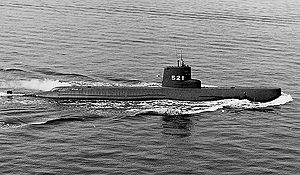 JDS Hayashio
| |
| Class overview | |
|---|---|
| Name | Hayashio class |
| Builders | |
| Operators | |
| Preceded by | Oyashio |
| Succeeded by | Natsushio class |
| Built | 1960–1962 |
| In commission | 1962–1979 |
| Planned | 2 |
| Completed | 2 |
| Retired | 2 |
| General characteristics | |
| Type | (Hunter-killer) submarine |
| Displacement |
|
| Length | 59 m (193 ft 7 in) |
| Beam | 6.5 m (21 ft 4 in) |
| Draft | 4.1 m (13 ft 5 in) |
| Propulsion |
|
| Speed |
|
| Complement | 43 |
| Armament | 3 × 533 mm (21 in) torpedo tubes |
The Hayashio-class submarine was the successor design to the Oyashio, and the predecessor of the Natsushio class with the Japan Maritime Self-Defense Force. Ordered in 1959, the boats were small with limited capability but were successful. Constructed in Japan from 1960 to 1962, they remained in service until 1979 when they were discarded.
Design and description
The Hayashio class were based on the United States Navy Barracuda-class submarines. They were small with limited capability and were shorter and wider than the preceding Japanese Oyashio. [1] The main mission of the class was for operations in coastal waters. [2] They were air conditioned and provided quality habitability for their crews and were considered a successful submarine design. [3] They measured 59 meters (193 ft 7 in) long overall with a beam of 6.5 m (21 ft 4 in) and a draft of 4.1 m (13 ft 5 in). They had a surfaced displacement of 650 tonnes (640 long tons) and 800 tonnes (790 long tons) submerged. Part of the design was to reduce hull resistance and to do this, external framing was used to improve internal space and create a better double hull. They had a crew of 43. [1]
The submarines were propelled by two propeller shafts powered by a diesel-electric system composed of two Sulzer-Mitsubishi diesel engines creating 1,300 kilowatts (1,700 shp) and two electric motors creating 970 kW (1,300 bhp). [4] The main storage batteries were water-cooled. This gave the vessels a maximum speed of 15 knots (28 km/h; 17 mph) surfaced and 12 knots (22 km/h; 14 mph) submerged. [1] [a] To improve underwater maneuverability, a joystick was installed instead of the traditional wheel at the helm position. The submarines mounted three torpedo tubes in the bow for 533-millimeter (21.0 in) torpedoes. The class used a water pressure system to launch torpedoes that eliminated the creation of water bubbles. [1]
Boats
| Hayashio class construction data [1] [5] | ||||||
|---|---|---|---|---|---|---|
| Pennant no. | Name | Builder | Laid down | Launched | Commissioned | Fate |
| SS-521 | Hayashio (はやしお) | Shin Mitusbishi, Kobe | 6 June 1960 | 31 July 1961 | 30 June 1962 | Decommissioned 25 July 1977 |
| SS-522 | Wakashio (わかしお) | Kawasaki, Kobe | 7 June 1960 | 28 August 1961 | 17 August 1962 | Decommissioned 23 March 1979 |
Construction and career
Both submarines were ordered in 1959 from Japanese shipyards. Both Hayashio and Wakashio entered service in 1962. [1] On 20 May 1970, Hayashio collided with a merchant vessel damaging the submarine's periscope. [6] They were both stricken from the naval vessel register in 1979, with Wakashio on 23 July 1979. [1]
Notes
Citations
- ^ a b c d e f g Gardiner, Chumbley & Budzbon 1995, p. 235.
- ^ Patalano 2015, 141.
- ^ a b Moore 1976, p. 281.
- ^ a b Couhat 1976, p. 243.
- ^ Moore 1979, p. 289.
- ^ "海上自衛隊ニュース,世界の艦船". 海人社 (in Japanese). Vol. 154. June 1970. p. 41.
References
- Couhat, Jean Labayle, ed. (1976). Combat Fleets of the World 1976/77: Their Ships, Aircraft, and Armament. Annapolis, Maryland: Naval Institute Press. ISBN 0-87021-183-8.
- Gardiner, Robert; Chumbley, Stephen & Budzbon, Przemysław, eds. (1995). Conway's All the World's Fighting Ships 1947–1995. Annapolis, Maryland: Naval Institute Press. ISBN 1-55750-132-7.
- Moore, John, ed. (1976). Jane's Fighting Ships 1976–77 (79th ed.). New York: Franklin Watts Incorporated. ISBN 0-531-03261-2.
- Moore, John, ed. (1979). Jane's Fighting Ships 1979–80 (82nd ed.). New York: Franklin Watts Incorporated. ISBN 0-531-03913-7.
- Patalano, Alessio (2015). Post-war Japan as a Sea Power: Imperial Legacy, Wartime Experience and the Making of a Navy. London: Bloomsbury. ISBN 978-1-47252-682-3.